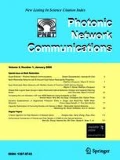Abstract
In dynamic IP-over-WDM networks efficient fault-management techniques become more difficult since as demands change with time the optimal logical topology varies as well. Changes in the virtual topology should be done with care because working IP LSPs routed on top of a virtual topology should not be interrupted. Reconfiguration of the virtual topology may also affect precomputed backup IP LSPs to be activated in case of failure meaning that backup IP LSPs would need to be recomputed after any change in the virtual topology. A good sense solution can be the dimensioning of the virtual topology for a worst case traffic scenario, having as goal the minimization of the network cost, for example, and then route dynamic IP LSPs on this virtual topology. The virtual topology would remain unchanged as long as possible, that is, until changes in the virtual topology are considered to bring considerable benefits. Since data services over IP are essentially of a best-effort nature, protection could be provided, using IP LSP protection, only when bandwidth is available in the virtual topology. The computation of backup IP LSPs does not interfere with working IP LSPs meaning that no service interruption will exist. Such a strategy, considered in this paper, allows resources to be used efficiently, since free bandwidth is used for backup purposes, while the normal delivery of traffic is guaranteed in peak traffic situations although having no protection guarantees. Our main objective is to quantify the spare capacity, which can be used for restoration (backup) purposes, over a virtual topology designed and optimized to carry a traffic scenario with no survivability and QoS requirements. We analyse the maximum protection (MP) problem in such IP-over-WDM network environment. Protection is provided to IP LSP requests whenever possible through bandwidth reservation in a backup IP LSP on the virtual topology. Besides the mathematical formalization of the MP problem, an upper bound and heuristic algorithms are proposed and evaluated. The traffic considered includes IP LSPs of different granularities and is the worst case traffic scenario for which the network should be dimensioned.
Similar content being viewed by others
References
G. Conte, M. Listanti, M. Settembre, R. Sabella, Strategy for protection and restoration of optical paths in WDM backbone networks for next-generation internet infrastrutures, IEEE/OSA Journal of Lightwave Technology, vol. 20, no. 8, (Aug 2002), pp. 1264–1276
K. Zhu, B. Mukherjee, Traffic grooming in an optical WDM mesh network, IEEE Journal on Selected Areas in Communications, vol. 20, no. 1, (Jan 2002), pp. 122–133
K. Bala, Internetworking between the IP and the optical layer, Optical Networks Magazine, vol. 2, no. 3, (May/Jun 2001), pp. 16–18
E. Mannie et al., Generalized multi-protocol label switching (GMPLS) architecture, Internet Draft, draft-ietf-ccamp-gmpls-architecture-02.txt (2002)
B. Rajagopalan, J. Luciani, D. Awduche, IP over optical networks: A Framework, Internet Draft, draft-ietf-ipo-framework-03.txt (2003)
P.-H. Ho, H. T. Mouftah, A framework for service-guaranteed shared protection in wdm mesh networks, IEEE Communications Magazine, vol. 40, no. 2, (Feb 2002), pp. 97–103
R. Berry, E. Modiano, reducing electronic multiplexing costs in SONET/WDM rings with dynamically changing traffic, IEEE Journal on Selected Areas in Communications, vol. 18, no. 10, (Oct 2000), pp. 1761–1771
N. Srinivas, C. Siva Ram Murthy, Design and dimensioning of a WDM mesh network to groom dynamically varying traffic, Photonic Network Communications, vol. 7, no. 2, (Mar 2004), pp. 179–191
L. Sahasrabuddhe, S. Ramamurthy, B. Mukherjee, Fault management in IP-Over-WDM networks: WDM protection versus IP restoration, IEEE Journal on Selected Areas in Communications, vol. 20, no. 1, (Jan 2002), pp. 21–33
Q. Zheng, G. Mohan, Protection approaches for dynamic traffic in IP/MPLS-over-WDM networks, IEEE Communications Magazine, vol. 41, no. 5, (May 2003), pp. S24–S29
O. Crochat, J. Le Boudec, Design protection for WDM optical networks, IEEE Journal on Selected Areas in Communications, vol. 16, no. 7, (Sep 1998), pp. 1158–1165
M. Sridharan, M. V. Salapaka, A. K. Somani, A practical approach to operating survivable WDM networks, IEEE Journal on Selected Areas in Communications, vol. 20, no. 1, (Jan 2002), pp. 34–46
D. Papadimitriou et al., Analysis of generalized MPLS-based recovery mechanisms, Internet Draft, draft-papadimitriou-ccamp-gmpls-recovery-analysis-03.txt (2002)
G. Mohan, C. Siva Ram Murthy, A. K. Somani, Efficient algorithms for routing dependable connections in WDM optical networks, IEEE/ACM Transactions on Networking, vol. 9, no. 5, (Oct 2001), pp. 553–565
B. T. Doshi, Subrahmanyam Dravida, P. Harshavardhana, Oded Hauser, Yufei Wang, Optical network design and restoration, Bell Labs Technical Journal, vol. 4, no. 1, (Jan/Mar 1999), pp. 58–84
S. Baroni, P. Bayvel, R. J. Gibbens, S. K. Korotky, Analysis and design of resilient multifiber wavelength-routed optical transport networks, IEEE/OSA Journal of Lightwave Technology, vol. 17, no. 5, (May 1999), pp. 743–758
Author information
Authors and Affiliations
Corresponding author
Rights and permissions
About this article
Cite this article
Correia, N.S.C., Medeiros, M.C.R. On the Maximum Protection Problem in IP-over-WDM Networks Using IP LSP Protection. Photon Netw Commun 10, 73–85 (2005). https://doi.org/10.1007/s11107-004-1696-1
Received:
Revised:
Accepted:
Issue Date:
DOI: https://doi.org/10.1007/s11107-004-1696-1




